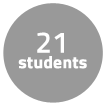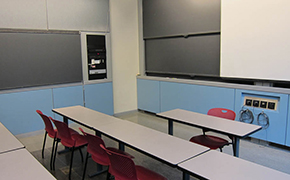Instructor Insights pages are part of the OCW Educator initiative, which seeks to enhance the value of OCW for educators.
Course Overview
This page focuses on the course WGS.101 Introduction to Women’s and Gender Studies as it was taught by Dr. Andrea Walsh in Fall 2014.
This course presents an introduction to Women's and Gender Studies (WGS), and challenges students to explore key issues in WGS scholarship and apply critical analysis and questioning to both historical and contemporary aspects of the study. Students are encouraged to bring their backgrounds and topical interests to both the in-class discussions and course assignments.
Course Outcomes
Course Goals for Students
The primary goal of this course is to familiarize students with key issues, questions and debates in Women’s and Gender Studies scholarship, both historical and contemporary. Another goal is to involve students in their own learning, and motivate critical reading. Students will be introduced to many of the critical questions and concepts that feminist scholars have developed as tools for thinking about gendered experience. Students will also explore the complex ways in which gender intersects with class, race, ethnicity, sexuality, and age within various spheres and institutions of society.
Possibilities for Further Study/Careers
Students often take this course as part of the WGS major, minor, or concentration and continue to complete coursework in WGS.
By making the structure of the course fairly transparent, students will be able to understand why they are studying the content.
—Dr. Andrea Walsh
Below, Dr. Andrea Walsh describes various aspects of how she teaches WGS.101 Introduction to Women’s and Gender Studies.
A variety of stereotypes surround WGS courses; these stereotypes haunt the WGS classroom. A little ways into the semester, we openly discuss these images in light of negative stereotypes surrounding the terms “feminism” and “feminist” in the United States. I encourage students to identify these images and I seek to counter these stereotypes. Most of these stereotypes portray the ideas that WGS is dogmatic, and that there is a “party line” to be parroted to earn a decent grade. Sometimes there is a myth that these classes are “consciousness-raising groups” and lack academic rigor. A few weeks in the classroom and exposure to a rigorous workload, accompanied by a style of lecture and discussion that is open and welcoming to different points of view, usually counter these myths.
One challenge common to most introductory classes is that there is a lot of material to cover, historically and theoretically. My advice to instructors is to acknowledge that you cannot cover everything, but that you can provide perspectives for thinking critically about a wide range of issues. Structuring the course carefully, identifying major perspectives early in the course, and “signposting” these perspectives throughout the semester are ways to approach this. By making the structure of the course fairly transparent, students will be able to understand why they are studying the content.
In addition to delivering knowledge, interdisciplinary and introductory courses, such as this one, help students develop the tools and framework to move forward in a particular field. WGS courses also prepare students for future research and writing in both humanities and social sciences. Students should be reminded of different ways to approach an issue such as the role of women in the military or the gendered wage gap in the United States and other countries.
Students come into this course with varied backgrounds, in terms of their knowledge of history, and especially U.S. history. In addition, some students have previous background in WGS, while others have none. I give students the freedom to explore issues of their own interest by offering choices in essay topics and oral presentations. Oral presentations on current events are intended to increase students’ engagement with the course content and to recognize its contemporary relevance. They also encourage students to practice their oral presentation skills.
Acknowledging the diversity of people’s educational and cultural backgrounds is essential and important. As the course continues to evolve, I would like to continue to integrate more global material. One way in which I try to advocate for a global point of view is through documentary films, which are a major resource in presenting social problems, understanding different cultures, and analyzing social movements.
Curriculum Information
Prerequisites
None
Requirements Satisfied
- HASS

- CI-H

Offered
Every spring and fall semester
Assessment
The students' grades were based on the following activities:
 15% Attendance and participation, and short homework and in-class writing exercises
15% Attendance and participation, and short homework and in-class writing exercises 10% Current event analysis oral presentation and write-up
10% Current event analysis oral presentation and write-up 5% Short write-up on a Women’s and Gender Studies event/program (film, lecture, reading)
5% Short write-up on a Women’s and Gender Studies event/program (film, lecture, reading) 70% Three major writing assignments
70% Three major writing assignmentsStudent Information

Breakdown by Year
During this iteration of the course, 67% of students were sophomores, 19% freshmen, 14% juniors, and no seniors, though this varies by term. Typically, graduate students do not enroll in this course.
Breakdown by Major
Students come from a range of departments including biology, brain and cognitive science, electrical engineering and computer science, mechanical engineering, political science, management, and materials science and engineering. There are also a few WGS majors who usually take the course.
Typical Student Background
Students are typically interested in gender issues, sometimes as a result of previous course background (other WGS classes at MIT or in high school). Students may also show interest through personal or political experience.
At MIT, since some majors reflect a minority of women, those individuals may be particularly interested in the status of women in STEM fields.
Enrollment Cap
Enrollment is restricted to 25 students because it is the CI-H limit for enrollment. The enrollment cap allows each student to have more opportunities to participate during class.
Usually 40 students express interest in enrolling in the course, and are selected based on level of interest and need. Because the course is offered every term, students are offered a spot in the next semester’s class if they are unable to get into the current semester’s offering.
During an average week, students were expected to spend 12 hours on the course, roughly divided as follows:
In Class
- Met 2 times per week for 1.5 hours per session; 26 sessions total; mandatory attendance.
- In an 80-minute class, the first 5 minutes might be spent on introductory announcements of assignments due, followed by 40 minutes of lecture, and 20 minutes of discussion, though this varies from class to class. A typical class may include in-class writing for about 5–10 minutes to stimulate discussion, with subsequent discussion referring to either in-class work or a homework assignment. Discussions may be structured within pairs or small groups, while other times may include the whole class. Sometimes the writing advisor gives presentations of 10-15 minutes that are related to major assignments as well as writing strategies and skills.
- In the second half of the term, students are asked to give 15-minute oral presentations in pairs. Usually one pair, and occasionally two, presents per class. In these cases, the breakdown of time spent in class might be 30 minutes of lecture, 10 minutes of general discussion, and 15 minutes for the oral presentation that includes 5 minutes of class discussion. Because this class is a CI-H course, students regularly practice both written and oral communication skills.
Out of Class
- 3 major writing assignments
- 1 oral presentation on a current event, to be delivered in class, with a partner
- 1 reflection assignment in response to attending a WGS-related event
- Short homework assignments throughout the course
Semester Breakdown
| WEEK | M | T | W | Th | F |
|---|---|---|---|---|---|
| 1 |  |  |  |  |  |
| 2 |  |  |  |  |  |
| 3 |  |  |  |  |  |
| 4 |  |  |  |  |  |
| 5 |  |  |  |  |  |
| 6 |  |  |  |  |  |
| 7 |  |  |  |  |  |
| 8 |  |  |  |  |  |
| 9 |  |  |  |  |  |
| 10 |  |  |  |  |  |
| 11 |  |  |  |  |  |
| 12 |  |  |  |  |  |
| 13 |  |  |  |  |  |
| 14 |  |  |  |  |  |
| 15 |  |  |  |  |  |
| 16 |  |  |  |  |  |
 No classes throughout MIT
No classes throughout MIT Seminar session
Seminar session Screening session
Screening session Essay revision due date
Essay revision due date No class session scheduled
No class session scheduled Student Presentations
Student Presentations Assignment due date
Assignment due dateLead Instructor (Dr. Andrea Walsh)
In preparation for each class, Dr. Walsh keeps up-to-date with new material in the field, re-reads old material, consults with colleagues on course design, and reviews student homework. These help her prepare for the themes that may emerge during lectures and discussion. She also prepares a one-page lecture handout that is distributed at the beginning of each class session.
Communication-Intensive Writing Advisor (Dr. Elizabeth Fox)
Students are asked to consult with the Communication-Intensive Writing Advisor during the process of planning for and writing one of the major writing assignments. These meetings can be scheduled at any point in the writing process: brainstorming, crafting the first draft, or revising. Most often, students are encouraged to meet with the writing advisor when writing and revising their first essays.


 Room 1 of 1
Room 1 of 1 